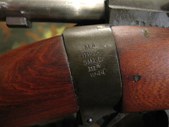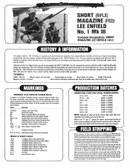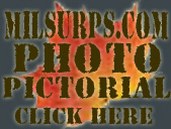-
FREE MEMBER
NO Posting or PM's Allowed

just inherited lee enfield..some q's
-
12-20-2008 05:15 PM
# ADS
Friends and Sponsors

-
Head Moderator
(Founding Partner)


Site Founder

It's one of these, except manufactured in 1942. Below is the Library entry for a rifle of mine.
1944 ShtLE (Short Lee-Enfield) No.1 MkIII* Infantry Rifle
(Manufactured by Lithgow, Australia)
 (Click PIC to Enlarge)
(Click PIC to Enlarge) Observations: (by "Stevo")
Note: Pics of rifle provided courtesy of MILSURPS.COM member Stevo.
The Rifle, Short, Magazine, Lee-Enfield, in it’s Mk III and Mk III* variants was the primary infantry rifle of Australian
Observations: (by "Stevo")
Note: Pics of rifle provided courtesy of MILSURPS.COM member Stevo.
The Rifle, Short, Magazine, Lee-Enfield, in it’s Mk III and Mk III* variants was the primary infantry rifle of Australian forces from circa World War One until the introduction of the L1 FAL rifle variant in the mid 1950's. It served with distinction from Gallipoli to Korea.
Serial markings will be found on the receiver ring, rear of bolt handle, nosecap bayonet lug, and normally on the barrel knox form (though not on this rifle). Coachwood stocked examples, as this one is, must be treated carefully to ensure the wood does not dry out or crack/split while removing it. Brass wood-reinforcing pins can be noted in many of the pictures. Virtually all Lithgow SMLEs produced after 1939 will be found stocked in Australian coachwood.
This rifle, while in unused condition, appears to have been issued. This is supported by the "6/45" marking stamped on the buttstock which indicates the rifle was "Returned to Arsenal" in June of 1945. This would normally imply a minor repair/part replacement or FTR (Factory Thorough Repair), but in the case of this rifle, there is no evidence of repair/replacement or FTR.
The majority of World War Two Australian MkIII*’s were marked “MA Lithgow”, signifying manufacture and assembly at Royal Australian Ordnance Factory Lithgow. This rifle is marked “MAO SMLE”, signifying assembly of the rifle at the Royal Australian Ordnance Factory Orange on a Lithgow made receiver.
This particular rifle was purchased in Toronto, Ontario in the early 1960's by my Father. It shows none of the paint evident on Australian No. 1s imported into Canada
forces from circa World War One until the introduction of the L1 FAL rifle variant in the mid 1950's. It served with distinction from Gallipoli to Korea.
Serial markings will be found on the receiver ring, rear of bolt handle, nosecap bayonet lug, and normally on the barrel knox form (though not on this rifle). Coachwood stocked examples, as this one is, must be treated carefully to ensure the wood does not dry out or crack/split while removing it. Brass wood-reinforcing pins can be noted in many of the pictures. Virtually all Lithgow SMLEs produced after 1939 will be found stocked in Australian coachwood.
This rifle, while in unused condition, appears to have been issued. This is supported by the "6/45" marking stamped on the buttstock which indicates the rifle was "Returned to Arsenal" in June of 1945. This would normally imply a minor repair/part replacement or FTR (Factory Thorough Repair), but in the case of this rifle, there is no evidence of repair/replacement or FTR.
The majority of World War Two Australian MkIII*’s were marked “MA Lithgow”, signifying manufacture and assembly at Royal Australian Ordnance Factory Lithgow. This rifle is marked “MAO SMLE”, signifying assembly of the rifle at the Royal Australian Ordnance Factory Orange on a Lithgow made receiver.
This particular rifle was purchased in Toronto, Ontario in the early 1960's by my Father. It shows none of the paint evident on Australian No. 1s imported into Canada during the ‘80’s and ‘90’s. These rifles were ex-Cadet issue and marked with either green paint, signifying “OK for use with ball” or yellow paint, signifying “OK for occasional use with ball”. The yellow markings were usually due to a minor imperfection like a pitted bore, poor trigger, bad bedding, a superficial stock crack, etc. These paint bands would have included the nosecap and extended to midway between the nosecap and barrel band.
The John Jovino Company of New York State imported large numbers of Lithgow rifles and parts. The rifles are marked JJCoNY,NY. These rifles should be inspected for the presence of brass recoil plates in the fore end. Some, but not all, JJCo rifles were made up from parts and these are commonly lacking the recoil plates. These recoil plates are necessary to prevent the coachwood stock from splitting under recoil which could occur with the firing of just a few rounds. Lithgow made SMLEs fitted with coachwood or Queensland maple stocks are the only SMLEs to feature these recoil plates.
Caution: On any SMLE, ensure that you remove the fore end before attempting to remove the buttstock. Failing to do this can result in a cracked fore end when removing the buttstock first.
I consider this rifle to be the most attractive military surplus rifle I have ever seen, because of it's condition and the beautiful colour and figure of the coachwood stock. But I'm biased.
during the ‘80’s and ‘90’s. These rifles were ex-Cadet issue and marked with either green paint, signifying “OK for use with ball” or yellow paint, signifying “OK for occasional use with ball”. The yellow markings were usually due to a minor imperfection like a pitted bore, poor trigger, bad bedding, a superficial stock crack, etc. These paint bands would have included the nosecap and extended to midway between the nosecap and barrel band.
The John Jovino Company of New York State imported large numbers of Lithgow rifles and parts. The rifles are marked JJCoNY,NY. These rifles should be inspected for the presence of brass recoil plates in the fore end. Some, but not all, JJCo rifles were made up from parts and these are commonly lacking the recoil plates. These recoil plates are necessary to prevent the coachwood stock from splitting under recoil which could occur with the firing of just a few rounds. Lithgow made SMLEs fitted with coachwood or Queensland maple stocks are the only SMLEs to feature these recoil plates.
Caution: On any SMLE, ensure that you remove the fore end before attempting to remove the buttstock. Failing to do this can result in a cracked fore end when removing the buttstock first.
I consider this rifle to be the most attractive military surplus rifle I have ever seen, because of it's condition and the beautiful colour and figure of the coachwood stock. But I'm biased.  Note: Special thanks to "Claven2" and "Son" (a member of Gunboards), for additional feedback and research.
Collector Comments and Feedback:
1. Found this very interesting brochure and instruciton manual contained in a post by JIMMYC on Gunboards:
Note: Special thanks to "Claven2" and "Son" (a member of Gunboards), for additional feedback and research.
Collector Comments and Feedback:
1. Found this very interesting brochure and instruciton manual contained in a post by JIMMYC on Gunboards:
"I was digging through some of my old papers, and I came upon this. I remember getting this when I purchased my Australian SMLE in 1990. So I thought I would share. I don't know if the information is valid, but there is a lot of good info if it is. (by JIMMYC)" ......... (Feedback by "Badger")
 (Click PIC to Enlarge)
(Click PIC to Enlarge)
2. Here's an interesting manual for Australian Enfield collectors. I can't remember where I found it, but if someone knows the source to thank and acknowledge here, please send me a PM and let me know. ..... (Feedback by "Badger")
1945 Australian Rifle Parts Identification List
Covers:
Rifle No.1 SMLE .303
Mark III, Mark III* and Emergency
Rifle No.3 Mk1*(T)
Rifle No.4 .303 Mk1 and Mk1*
Discharger Grenade Rifle No.1 Mk1 2 1/2"
 (Click PIC to read and save Adobe PDF File)
(Click PIC to read and save Adobe PDF File)
(Right Click on PIC and choose "Save Target As..." to download PDF file)
3. On some systems with Microsoft's Internet Explorer, after you click on images in the MKB to ENLARGE them, you may find they automatically size smaller in your browser's window making them hard to read. The auto sizing is your browser's way of keeping images entirely within the screen size you have set.
If this happens, move your mouse pointer to the bottom right corner of the pic and hold it there. You will see a small box open up with four arrows point outwards and it will say "Expand to Regular Size". Click this box and the pic will open up to it's normal size and you should now be able to read any text and make out small details in the pic. ..... (Feedback by "Badger")
-
-
-
FREE MEMBER
NO Posting or PM's Allowed

thanks for the info! approx how much would this unit be worth?
Matt
-
Head Moderator
(Founding Partner)


Site Founder


Originally Posted by
awesomeame

thanks for the info! approx how much would this unit be worth?
Matt
Matt,
With collectible rifles, price can vary widely based on factors like overall condition, bore condition and whether or not all the serial numbers match. The Lithgow rifles may fetch a higher price compared to British
rifles may fetch a higher price compared to British or Indian SMLEs also.
or Indian SMLEs also.
For a complete, unmodified Lithgow SMLE price could range from $250 to $500, IMO, depending on the condition, buyer, and current market demand.
Pictures would be a big help in determining value.
Merry Christmas,
Stevo
-
-
FREE MEMBER
NO Posting or PM's Allowed

Well I finally figured out how to put pictures on the internet!! Hopefully these pics will help for a rough guesstimate on this thing's value. Bore is fine.
http://www.execulink.com/~wscholtes/...d/DSCN3937.JPG
for more pics:
http://www.execulink.com/~wscholtes/enfield
any help appreciated, thanks a lot
Matt
-
Sure looks nice!
Now, something else that will have an influence on value is in which part of the world you live. Where are you?
Amongst collectors, another aspect that has its importance is the "matching" of the numbers. The more numbers match (serial number found on many parts), the higher the potential value.
Louis
-
-
FREE MEMBER
NO Posting or PM's Allowed

Hi, this is my first post here. I was bequeathed a whole assortment of reloading gear and started tinkering with some of my old rifles. Included in the collection was a No.4 Mk.I Enfield. This started out as looking for load data, but scouring the forums here got me interested in some more info about the rifle. I always liked the Enfields, even though I am a fan of the K98 (blasphemy, I know), but could never find one in good condition. My local gunshop signed a deal with the police few years back and managed to get confiscated firearms at rock bottom prices. Sure enough, one day he had this rifle sitting there and I picked it up for $90 about 4 years ago. The furniture is a bit roughed up but the receiver, barrel and bore are immaculate. Besides general information, I am looking for good loads that involve H4831 powder (I have about 8 pounds of it). So far I know that the rifle was manufactured in November, 1948 at Fazarkley. Other than that I am in the dark on info and value. Anything would be appreciated
(blasphemy, I know), but could never find one in good condition. My local gunshop signed a deal with the police few years back and managed to get confiscated firearms at rock bottom prices. Sure enough, one day he had this rifle sitting there and I picked it up for $90 about 4 years ago. The furniture is a bit roughed up but the receiver, barrel and bore are immaculate. Besides general information, I am looking for good loads that involve H4831 powder (I have about 8 pounds of it). So far I know that the rifle was manufactured in November, 1948 at Fazarkley. Other than that I am in the dark on info and value. Anything would be appreciated  .
.
Serial Number: PF37048
Manufacture Date: 11/48
There are other symbols, but I do not know what they mean (whats the little "A" behind the trigger?? Oh yeah, and how much for the cat? Its my girlfriends...I hate it.....







-
The "U" with arrow on the receiver ring is a mark indicating ownership by the South African Military. The trigger guard mark shows it (trigger guard) was made by Longbranch in Canada and has the Canadian "C" with broad arrow mark
and has the Canadian "C" with broad arrow mark
-
-
Legacy Member


Is it a South African ownership mark? The reason I am asking is because the "U" is upside down. I thought the arrow was to be pointing in the direction of the opened end, not the closed end of the "U".
I do not know if they did it both ways which is why I am asking. I have only seen the marking in reference books.
-
-
I have examples of the arrow going both ways within the "U"
I suspect it depended if the "Hairy Back" who stamped it was hung over or not 
-
Thank You to Amatikulu For This Useful Post:
S.M.L.E. III* 1942"
















 Register To Reply
Register To Reply
















